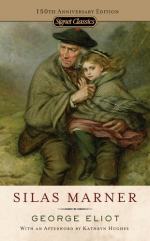|
|
Silas Marner Author/Context
George Eliot, christened Mary Anne Evans, was born on November 22, 1819. Mary Anne was the third child of Robert Evans and Christiana Pearson, after Chrissey and Isaac, and before the boy twins, who died in infancy. Mary Anne spent her childhood and adolescence between her family's farm, Griff House, in Nuneaton, Warwickshire, and the two boarding schools she was sent to. Mary Anne idolized her older brother, Isaac, and despaired when he began to distance himself from her. Turning to books and reading for comfort, Mary Anne also found solace in the Evangelical preachings of her teacher, Miss Maria Lewis. Miss Lewis's teachings provided Mary Anne with the religious devotion that permeated most of her adolescence.
After her mother died of breast cancer on February 3, 1836 and her older sister, Chrissey, married in 1837, Mary Anne took charge of her father's household. Mary Anne and her father moved to a house near Coventry. It was during this time that Mary Anne changed her name to 'Mary Ann' and became known as 'Miss Evans.' Mary Ann nursed her father during his last years, especially when he fell sick with kidney disease. She was very much devastated when her father finally died on May 30, 1849.
Mary Ann changed her name yet again, this time to 'Marian' in 1851. She travelled to London, where she embarked on an adulterous affair with the married Mr. John Chapman. Her residence at 142 Strand gave her access to the literary and artistic circles in London at the time - most importantly, she began to associate with the men from the Westminster Review. Chapman bought the Westminster Review and gave the editorship to Marian Evans. Chapman's wife, Susanna, and mistress, Elisabeth Tilley, were jealous of Chapman's attention to Marian and made her leave London.
However, Marian returned to London later that year, with her dear friend Cara Bray at her side. They met G.H. (George Henry) Lewes, the charming, intelligent writer and philosopher. Lewes was married, but his wife had left him, and a divorce was impossible. Although Cara Bray and Marian's other friends severely disliked Lewes, Marian became fond of him and even began to love him, but she could not tell her friends of her growing affection for him. She loved his knowledge of literature, his fluency of languages, his confidence, and his intelligence; they both shared a love for literature, especially German literature, religion, and philosophy. In 1854, they prepared to live together openly in Germany, settling in Weimar and then Berlin. News of their relationship shocked many of their friends and their family back home in England and they shunned Marian and Lewes. However, both Marian and Lewes made it clear that their relationship was no ordinary affair and that they intended to be with each other. In 1855, they returned to England, where Marian was anxious how society would receive them. Marian had stopped editing for the Westminster Review because the job was unpaid, but continued to write articles.
As Marian and Lewes continued to live together as man and wife, people generally began to accept them as a married couple. Lewes encouraged Marian to write fiction. She sent off her first work, "Amos Barton," to the English publisher John Blackwood in 1856 under the pseudonym 'George Eliot.' She wanted critics to judge her on merit alone and not by her relationship with Lewes, taking the name 'George Eliot,' as George was Lewes's first name. Later that year, George Eliot worked on Scenes of Clerical Life, published in 1858. Not even her close friends, John Chapman, the Brays, and Bessie Parkes, knew what Marian was doing for a living.
In 1858, Lewes and Marian set off for Munich and Dresden, where Marian focused her energy on her fiction. Adam Bede (1859) was based on Marian's memories of her childhood and youth in Nuneaton and became an immediate success. The Mill on the Floss (1860), Eliot's first great novel, was by far Eliot's most autobiographical, focusing on her relationship with her beloved brother, Isaac, in Maggie and Tom Tulliver. Published in 1861, Silas Marner soon followed the success of The Mill on the Floss, also based on Marian's childhood in Warwickshire as a young girl. Eliot's other works include Romola (1862-1863), Felix Holt (1866), The Spanish Gypsy (1868), and The Legend of Jubal and other Poems (1874). Her greatest masterpiece, Middlemarch, was published in 1871.
Lewes's death in 1878 left Marian more devastated than she had ever been in her life, losing a friend, a companion, and a lover. Marian married J.W. Cross, a friend of hers and an American banker twenty years her junior. Soon after she married Cross, George Eliot died on December 22, 1880.
Adam Bede, Silas Marner, and The Mill on the Floss focus especially on Marian's childhood memories of the rural countryside in Warwickshire: the landscape and its inhabitants. She also recalled her religious views and integrated them into the stories.
"She shocked family and friends more than once with her actions - losing her faith and refusing to attend church, persuing a journalistic career in London, living with a married man, and finally marrying a man so much younger than herself - but her desire was always to please, to conciliate to conform if she could. In her novels she dramatized these and similar paradoxes in a variety of ways, skilfully and sympathetically putting difficult choices before her characters and showing their human frailty and the sometimes disastrous consequences of dubious actions undertaken out of mixed and confused motives." (Ashton 381).
Ashton, Rosemary. George Eliot: A Life. Allen Lane. New York: 1996.
Eliot, George. Silas Marner. The Zodiac Press. London: 1978.
Hughes, Kathryn. George Eliot: The Last Victorian. Farrah, Strauss and Giroux. New York: 1999.
Laski, Marghanita. George Eliot and Her World. Thames and Hudson. London: 1973.




